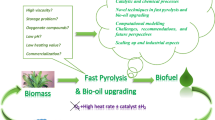Abstract
The use of fast pyrolysis oil as a potential renewable liquid transportation fuel alternative to crude oil depends on successful catalytic upgrading to produce a refinery-ready product with oxygen content and qualities (i.e., specific functional group or compound content) compatible with the product’s proposed refinery insertion point. Similar to crude oil hydrotreating, catalytic upgrading of bio-oil requires high temperature and pressure. However, processing thermally unstable pyrolysis oil is not straightforward. For years, a two-temperature, downflow trickle bed reactor using sulfided catalysts was the state-of-the art for continuous operation. However, pressure excursion due to plug formation still occurred, typically at the high-temperature transition zone, and led to a process shutdown within 140 h. A plug typically consists of polymerized bio-oil and inorganic constituents that bind catalysts at specific portions preventing liquid and gas flow through the bed, resulting to a potential pressure incursion. Recently, two factors were found to enable continuous operation by preventing reactor shutdown due to plug formation: (1) a bio-oil pretreatment process prior to the two-temperature reactor, and (2) a robust commercial catalyst for the high temperature zone reactor. Here, we report the use and characterization of bio-oil that was pre-treated at 413 K and 8.4 MPa under flowing H2 (500 L H2/L bio-oil, 0.5 L bio-oil/L catalyst bed) to enable the long-term (cumulative 1440-h) bio-oil hydroprocessing.




Similar content being viewed by others
References
Bridgwater AV (2012) Review of fast pyrolysis of biomass and product upgrading. Biomass Bioenergy 38:68–94
Diebold JP (2000) A review of the chemical and physical mechanisms of the storage stability of fast pyrolysis bio-oils. National Renewable Energy Laboratory, Golden
Elliott DC (2007) Historical developments in hydroprocessing bio-oils. Energy Fuels 21(3):1792–1815
Baker, E.G. and D.C. Elliott, Catalytic upgrading of biomass pyrolysis oils. Research in Thermochemical Biomass Conversion, ed. A.V. Bridgwater and J.L. Kuester. 1988, Barking Essex: Elsevier Appl Sci Publ Ltd. 883-895
Elliott DC et al (2009) Catalytic hydroprocessing of biomass fast pyrolysis bio-oil to produce hydrocarbon products. Environ Progr Sust Energy 28(3):441–449
Wildschut J et al (2010) Insights in the hydrotreatment of fast pyrolysis oil using a ruthenium on carbon catalyst. Energy Environ Sci 3(7):962–970
Elliott DC et al (2012) Catalytic hydroprocessing of fast pyrolysis bio-oil from Pine Sawdust. Energy Fuels 26(6):3891–3896
Zacher AH et al (2014) A review and perspective of recent bio-oil hydrotreating research. Green Chem 16(2):491–515
Weber RS, Olarte MV, Wang H (2015) Modeling the kinetics of deactivation of catalysts during the upgrading of bio-oil. Energy Fuels 29(1):273–277
De Miguel Mercader F (2011) Competition between hydrotreating and polymerization reactions during pyrolysis oil hydrodeoxygenation. AIChE J 57(11):3160–3170
Olarte MV et al (2013) Towards long-term fast pyrolysis oil catalytic upgrading. Abstr Pap Am Chem Soc 246:1
Jones S et al (2014) Fast pyrolysis and hydrotreating: 2013 State of Technology R&D and Projections to 2017. Pacific Northwest National Laboratory, Richland
Zacher, A., M. Olarte, and D. Elliott. Enabling extended catalyst lifetime in fixed bed hydrotreating of bio-oil. in tcbiomass 2013. 2013. Chicago, Illinois
Zacher AH et al (2014) Pyrolysis of woody residue feedstocks: upgrading of bio-oils from mountain-pine-beetle-killed trees and hog fuel. Energy Fuels 28(12):7510–7516
Nicolaides GM (1984) The chemical characterization of pyrolytic oils, in Department of Chemical Engineering. University of Waterloo, Waterloo
Speight JG (2002) Handbook of petroleum product analysis. Wiley, New York
Gagnon J, Kaliaguine S (1988) Catalytic hydrotreatment of vacuum pyrolysis oils from wood. Ind Eng Chem Res 27(10):1783–1788
Elliott DC et al (2012) Results of the IEA Round Robin on viscosity and stability of fast pyrolysis bio-oils. Energy Fuels 26(6):3769–3776
Christensen ED et al (2011) Analysis of oxygenated compounds in hydrotreated biomass fast pyrolysis oil distillate fractions. Energy Fuels 25(11):5462–5471
Silverstein R, Webster F, Kiemle D (2005) Spectrometric identification of organic compounds. Wiley, New York
Mullen CA, Strahan GD, Boateng AA (2009) Characterization of various fast-pyrolysis bio-oils by NMR spectroscopy†. Energy Fuels 23(5):2707–2718
Sanna A, Vispute TP, Huber GW (2015) Hydrodeoxygenation of the aqueous fraction of bio-oil with Ru/C and Pt/C catalysts. Appl Catal B 165:446–456
Christensen, E., T. Alleman, and R. McCormick, Totalacid value titration of hydrotreated biomass fast pyrolysis oil: Determination of carboxylic acids and phenolics with multiple end point detection. Abstracts of Papers of the American Chemical Society, 2013. 245
Oasmaa A, Elliott DC, Korhonen J (2010) Acidity of biomass fast pyrolysis bio-oils. Energy Fuels 24(12):6548–6554
Wang H, Male J, Wang Y (2013) Recent advances in hydrotreating of pyrolysis bio-oil and its oxygen-containing model compounds. ACS Catal 3(5):1047–1070
Acknowledgments
The authors gratefully acknowledge the U.S. Department of Energy, Office of Energy Efficiency and Renewable Energy, Bioenergy Technologies Office for funding for this work. Pacific Northwest National Laboratory is operated for the U.S. Department of Energy by Battelle under Contract DE-AC06-76RLO 1830. The authors also thank Shari X. Li (PNNL) for surface area/pore volume measurement and Todd Hart (PNNL) for aging study on the feed oil.
Author information
Authors and Affiliations
Corresponding authors
Rights and permissions
About this article
Cite this article
Olarte, M.V., Zacher, A.H., Padmaperuma, A.B. et al. Stabilization of Softwood-Derived Pyrolysis Oils for Continuous Bio-oil Hydroprocessing. Top Catal 59, 55–64 (2016). https://doi.org/10.1007/s11244-015-0505-7
Published:
Issue Date:
DOI: https://doi.org/10.1007/s11244-015-0505-7




